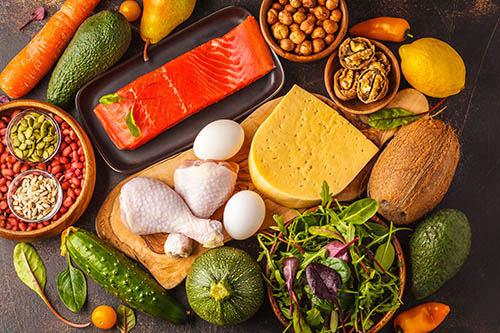Those summer diets are picking up their yearly steam: Should you try them?

Blog post contributed by Michelle Jaelin, TV and digital media Nutrition Expert, licensed registered dietitian, creative food content developer and President of NutritionArtist.com.
When spring arrives, we start hearing about “bikini bodies,” with people around us talking about going on diets in order to get “beach-body ready.” Maybe losing weight for bikini season is something you’ve considered too. Hey, we all want to feel great in a bathing suit. Is a “fat-shedding” diet the way to go? We could talk for hours about understanding and loving your own natural beauty, but if you are looking to lose weight for the summer, then I want to talk a bit about fad diets.
(Editor’s note: Michelle has a bit more on this line of thinking at the end of this post, and it’s worth sticking around for.)
So what are the current popular diet trends, and are they good for you? Here are five ways popular ways of eating I analyzed to help you make a more informed choice for yourself.
Keto Diet

What started as a medical diet in the 1920s to help control seizures in people with epilepsy has become mainstream for weight loss. The keto diet breakdown involves consuming a high fat, moderate protein and low carbohydrate diet. The goal of this diet when used for weight loss is to change your body to burn fat instead of sugar (what your body normally uses for energy). This is known as ketosis. People following the ketogenic diet need to eat a very low carbohydrate diet of less than 20-50 g of carbs for several days (on average 2-7 days) in order to reach a state of ketosis. Keep in mind: one medium banana has approximately 27 g of carbohydrates!
Foods allowed on this diet include: High fat foods, including butter, coconut oil, bacon, high fat dairy products and animal protein, such as beef, pork and chicken. Leafy green vegetables low in carbohydrates, such as (such as kale, Swiss chard, spinach), cauliflower, broccoli, Brussels sprouts, asparagus, bell peppers, onions, garlic, mushrooms, cucumber, celery, and summer squash are also permitted. A small amount of berries are allowed because they tend to be lower in carbs.
Why I am not in favour of Keto Diet:
Constipation
This diet is meat heavy, allowing dieters to eat bacon, but not whole grains like barley, oats, whole grain bread, or legumes such as chickpeas, lentils and kidney beans. Most fruits are also not permitted. Whole grains, legumes and fruits are higher in soluble fibre, which is necessary for digestive health. Therefore, keto dieters often experience constipation.
Nutrient Deficiencies
If you’re not eating a wide variety of vegetables, fruits, and whole grains, you may be at risk for deficiencies in micronutrients, including selenium, magnesium, phosphorus, and vitamins B and C.
Atkins Diet
Similar to the keto diet but with some distinct differences, Dr. Atkins brought his diet into the mainstream in the 1970s. Compared with the keto diet, the Atkins diet is higher in protein and carbs, and lower in fat. It is less restrictive than keto in that it has four dieting phases. In each phase, dieters change their macronutrient (protein, carbs and fat) ratio intake an add back more carbs into their diet. Because of this change, Atkins followers do not go into a state of ketosis, where the body is using fat as energy instead of carbohydrates.
Why I am not in favour of the Atkins Diet:
Many dieters find that when they add carbohydrates back into their diets, they gain back the weight they lost initially. As this diet is divided up into four stages, the change in the macronutrient ratios can be confusing for the person following the plan. Although Atkins is less restrictive than keto, you really do want a diet that you can maintain and sustain for your life. If this is a temporary plan to lose pounds quickly, it might work, but it is not sustainable or healthy in the long term.P
Pegan Diet

The Pegan Diet (not to be confused with paganism the religion) takes the best of both worlds of the paleo and vegan diets. A quick recap on what both of them are:
The paleo diet allows consumption of foods only foods available during the Paleolithic era, 2.6 million years ago: vegetables, fruits, nuts, fish, and meat. No dairy, grains, sugar, legumes, oils, salt, alcohol allowed. The vegan diet prescribes no animal products, which includes cheese, eggs and honey.
What you can eat on the Pegan Diet
Pegan allows vegetables (but only low glycemic ones, such as leafy greens but not higher glycemic index ones such as sweet potato or carrots), fruit, nuts like almonds, pistachios, walnuts (but not peanuts), seeds, fish (but only low mercury fish), meat (but only grass-fed beef, pork and chicken), eggs, and olive and avocado oil. Stay away from pesticides, antibiotics, hormones, and GMO foods. Choose organic foods (which often are grown with pesticides…). Avoid gluten and eat whole grain gluten-free foods sparingly.
My issue with this diet is there are too many rules and restrictions. How could anyone be normal around food with so much red tape surrounding it? It does seem like a diet that promotes fear of food versus eating healthy and embracing good food. My other gripe with this diet is that it is expensive and elitist. Only grass-fed, organic, non-GMO, gluten free foods? The average Canadian family is expected to spend $400 more on food in 2019, making this diet more of a novelty for those that can afford it, but not feasible for many due to cost.
Intermittent Fasting (IF)
Fasting has traditionally been practiced for religious reasons but has been adopted in recent years for weight loss purposes. IF is an eating pattern that cycles between periods of fasting and eating. It’s not a diet in the conventional sense of eating certain foods and avoiding others, but more accurately describes an eating pattern. It doesn’t specify which foods you should eat but rather when you should eat them. During fasting periods, only no calorie fluids such as water, tea and black coffee can be consumed. During eating periods, whole, nutritious foods should be eaten. Common intermittent fasting methods involve daily 16-hour fasts or fasting for 24 hours, twice per week.
Why I’m not for Intermittent Fasting
Restriction can lead to ravenous hunger. You are supposed to eat whole, healthy foods during eating periods, however people have reported either binge eating or eating more high calorie, high fat and sugar foods due to cravings after going for prolonged periods of time without eating.
There have also been reports of women not getting their periods and/or decreased fertility when doing IF for a long period of time. Furthermore, careful consideration about whether to adopt the diet should also be made for people with medical conditions such as diabetes, eating disorders, or mental health issues: such as sleep issues, anxiety, chronic stress.
Plant Based Diet
Plant-based eating focuses on eating foods primarily from plants. This includes not only fruits and vegetables, but also nuts, seeds, oils, whole grains, legumes, and beans. It doesn’t mean you are vegetarian or vegan and never consume any meat or dairy. Rather, you choose more foods from plant sources.
Canada’s new Food Guide came out earlier this year emphasizes plant-based protein alongside other proteins like meat and dairy. This is a great way to expand your personal palate and try new proteins, or mix proteins (beef and lentil chili sounds pretty good to me!).
The new food guide encourages Canadians to use the plate method for healthy eating. To do this, you fill:
- Half your plate with plant foods (vegetables and fruits).
- One quarter of your plate with carbohydrates (whole grain pasta or barley).
- One quarter of your plate with protein (meat, tofu, fish, cheese).
The food guide also has other tips on how Canadians can eat healthier. This includes meal planning, cooking more foods from scratch and eating together with friends and family. For the resource, go to: https://food-guide.canada.ca/en/
Bottom Line:
I am not a fan of temporary or unsustainable diets. They all preach restriction and removal of certain foods or food groups for a quick way to shed pounds and “look good.” But really, there is no one size fits all approach to eating.
Low carb diets like keto and Atkins are quite popular, but I highly suggest consuming more whole grains for their nutritional benefits. Oats, barley, and whole wheat products help to ensure regularity, maintain digestive health and are also sources of b-vitamins, minerals and antioxidants. Ensure that more than half of your grain servings are whole grains!
Most importantly: All bodies are good bodies. They are influenced by our genetics, our environment, those delicious treats you enjoy once in a while, and by different life stages. You already have a summer body. You’ve always had it. You also have the right to wear whatever you want, be it a bathing suit, a unicorn onesie (they’re cozy and soft), a dress, or track pants!
You have the right to be exactly who you are.
Have you felt pressured to try one of these diets to get “summer body” ready? Comment below and let us know! Have you tried one? What was your experience?

Michelle Jaelin is TV and digital media Nutrition Expert, licensed registered dietitian, creative food content developer and President of NutritionArtist.com. She focuses on sharing practical nutrition and cooking tips, and bringing credible nutrition information to the public. She resides on the Hamilton mountain with her spouse and rescue dog. Follow her @nutritionartist on Instagram and Twitter.
